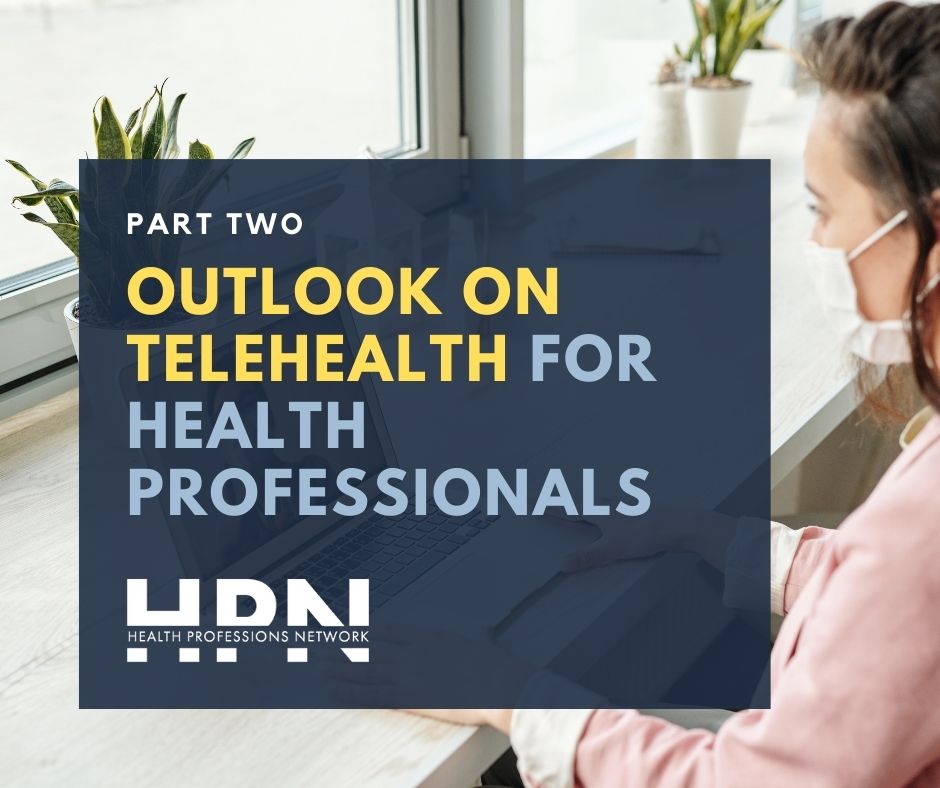On October 14, the Centers for Medicare & Medicaid Services (CMS) announced a further eleven services that will be eligible for reimbursement through Medicare when delivered via telehealth, including even cardiac rehabilitation. The move is just the latest in a stream of temporary policies that were introduced in response to the COVID-19 pandemic, designed to encourage and even stretch telemedicine use to new areas and reduce the risk of transmission of the virus. Many are calling for these temporary policies to be made permanent, even if or when we overcome challenges specific to COVID-19. What does that mean in terms of the outlook on telehealth for health professionals? Is a continued, large expansion of telehealth the future, or should we pump the breaks on the hype?
In the first part of this two-part blog, we took an in-depth look at the regulatory environment and trends from COVID-19 to beyond that may increase utilization of telehealth. In this second part, we'll take a look at counter arguments tempering expectations of telehealth and reaching a comprehensive outlook for current and future health professionals.
Note: this blog is continued from part one, here.
Outlook on Telehealth for Health Professionals: The Argument for Less
Even in our increasingly polarized time, and as we wait for the results of an election with the highest percentage turnout in a century, the call for making temporary regulatory waivers permanent has gained wide-ranging and bipartisan support. But some have called for caution in prescribing blanket policies to widely embrace further telehealth expansion across disciplines, and their perspectives should certainly temper our 2.
In a June 30 editorial in Harvard Business Review, Commonwealth Fund president Dr. David Blumenthal, MD, laid out a number of reasons why telemedicine may not be the unstoppable wave of the future. "Doctors and patients alike must be wondering if this is the beginning of a whole new kind of doctor–patient relationship, one that might totally transform our health care system," writes Blumenthal. "I’m not convinced, and Americans may not be either as the initial telehealth surge appears to be leveling off."
Perhaps part of that is due to the fact that 41 percent of older adults more likely to have chronic conditions and need high-contact health care delivery still lack access to high-speed internet connections at home. Indeed, in the latest update on outpatient care visits, visits have largely returned to pre-pandemic levels, though not necessarily across the board.
Blumenthal is no luddite, but he stresses the importance of developing trusting relationships in the delivery of health care, and suggests that in-person visits are crucial to that end. "That trust — the kind that lets anxious patients return to sleep at night, the kind that settles the stomach of a new mother with a sick baby — grows fastest and strongest through in-person relationships," he writes.
Plus, he argues, "There is no diagnostic test more cost-effective than the laying on of hands." An eloquent and interesting statement. While arguing for the qualitative value of in-person visits, he also invokes another leg of the three-legged stool of health reform, or the "Triple Aim," by discussing cost-effectiveness.

Could Telehealth Increase Health Care Costs?
Of course, cost is crucial to the discussion of telehealth, as it is touted as a way to reduce costs of health care delivery in a number of contexts by making professionals more efficient. But others caution that the reality isn't so simple. Equivalent compensation of telehealth visits may result in overutilization and thus rising costs.
"Telemedicine’s ability to make care convenient and more accessible — the key to its enormous potential to improve the health of many patients — may also be its Achilles’ heel," reads an outstanding August 5 report from the Commonwealth Fund, written by Ateev Mehrotra, Bill Wang and Gregory Snyder of Harvard Medical School and Tufts University. "In some cases, telemedicine is too convenient, even encouraging excessive use of care." (Emphasis is mine.)
For example, after an in-person visit, a physician could easily add a quick follow-up telemedicine visit that increases costs without substantially improving health. Not surprisingly, the Congressional Budget Office has projected that telemedicine expansions will increase health care spending.12
Telemedicine: What Should the Post-Pandemic Regulatory and Payment Landscape Look Like? - The Commonwealth Fund
With this in mind, the report outlines a far more comprehensive roadmap for the outlook on telehealth for health professionals, with a focus on areas where telemedicine can deliver the most value, especially where access to in-person health care visits may be more difficult.
The authors also stress the importance of maintaining simplicity in payment and regulatory policy, while balancing the goal of "encouraging only high-value telemedicine." The result of their analysis is six comprehensive yet simple policy recommendations. But if professions are counting on time-limited regulatory waivers being rolled back after the pandemic, they may be disappointed:
- "Increase use of alternative payment models.
- "Make permanent nearly all regulatory waivers introduced during the pandemic.
- "Cover all forms of telemedicine for high-risk patient populations where access is likely difficult.
- "For the rest of the population, cover telemedicine only where there is evidence of value or there is compelling need.
- "Pay for telemedicine visits at a lower rate than for in-person visits and avoid telemedicine parity laws.
- "Encourage consistency across insurers."
If these thoughtful recommendations are closer to our post-pandemic "new normal" than a call to continue telemedicine parity waivers, it is likely that the outlook on telehealth for health professionals will be one of incremental, though perhaps significant, growth. Though, it was perhaps always unlikely that the world would change completely over night, regardless of the external pressure of a global pandemic.

Join us for HPN's Virtual Fall Conference next week to discuss further.
One of the authors of this outstanding report, and an associate professor of health care policy and medicine at Harvard Medical School, Dr. Ateev Mehrotra, MD, MPH, will be joining us to speak on this topic during the the Health Professions Network Virtual Fall Conference, at 11AM Eastern on Thursday, November 12.
Dr. Mehrotra is a hugely impactful and oft-cited thought-leader and researcher on health care delivery innovations such as retail clinics and telemedicine and their impact on quality, cost and access to health care. He's recently been called to speak to Congress, the New York Times, and many more, to discuss the expansion of telehealth during COVID-19.
On Thursday, November 12, Dr. Mehrotra will feature as one outstanding part of our two hours of sessions focused on "The New Normal"—taking a deeper look at the future of health professions, and health profession associations, during and following the COVID-19 pandemic.
Pay what you think is fair based on your planned participation for you and your colleagues to attend a three-day virtual conference with two-to-four hours of keynote speakers, sessions, collaborative discussions and networking events with HPN leaders, members and fellow attendees! We're so excited to connect!


